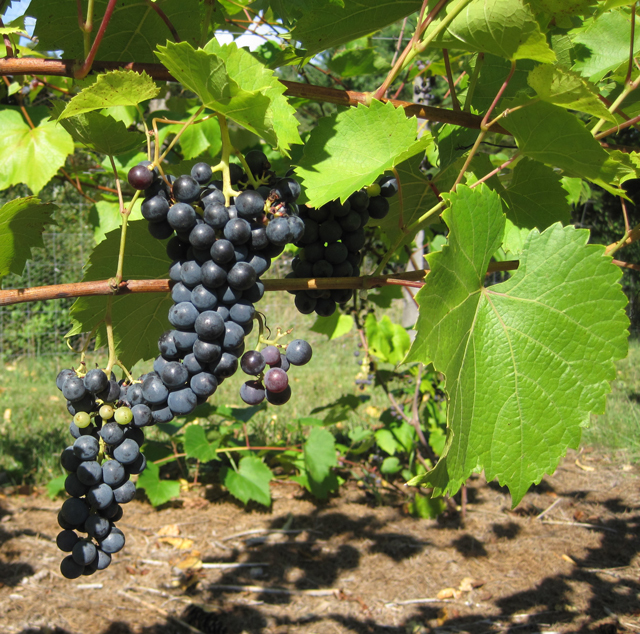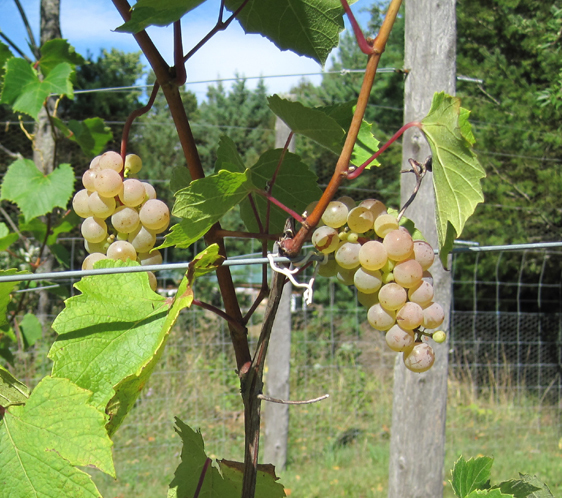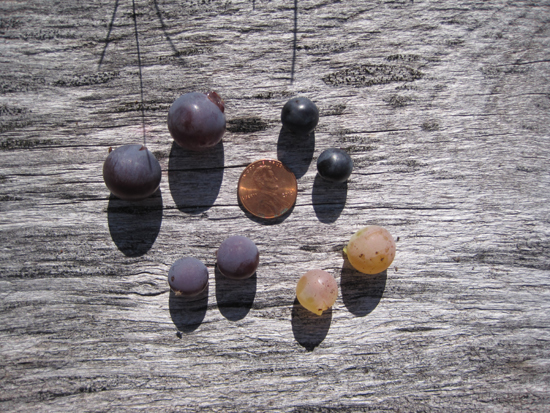I came across a new Canadian hardy grape this year from Vignes chez soi. Rolland.
From their facebook page:
The Roland
100 % Quebec Grape Variety! 
It was discovered in the early 2000 s by Roland Boisvert at la pocatière!
It is a green grape with seeds of exceptional qualities!
It has a divine flavor of peach, apricot and hint of maple syrup!
It’s very sweet.
Its taste qualities make it one of our favorite grape varieties among our selection!
It’s very rustic. Although we still have very little data, it seems at least as rustic as somerset that resists without any winter protection up to-35°C!
He’s very hasty! Maturity Mid-August!
Its exceptional flavour makes it a table grape to be eaten fresh! It also produces a succulent juice and an excellent verjus (Grape pressed before maturity! )
Anyway, you’ll get it!.. one of our big favorites!
For more information, here is an excellent article to read on the Roland (P10 and 11 of the document):
Here is a rough English translation:
Le Roland, a grape from the pocatois terroir "Have the crops been good this year? This is the question most often asked in the autumn by enthusiasts of horticulture market gardening and fruit. Personally, I am still surprised and delighted, even after more than ten years of harvesting grapes, to see so generously produce several varieties of vines in our garden. Since the end of August, ripe grapes fill our table and the harvest has just finished, in mid-October. The first to mature is the Roland whose little story is the pride of the one who welcomed him in this world, my spouse, Roland Boisvert.
A spontaneous sowing! Like apple trees, the vines must be cut to propagate the same variety. If you sow an apple seed or a grape seed, you will be surprised to discover a new variety, quite different sometimes from the original fruit. The taste quality and the size of the fruits obtained will be random. So you can get very good, like very bad.
In 2000, freshly retired from the ITA of La Pocatière where he taught horticulture for 30 years, Roland installed the vines, of various varieties, planted a few years earlier in his garden located between Mountain Ronde and the Pointe Mountain in La Pocatière. The following year, he realized that a spontaneous sowing developed, very vigorously besides another plant. Quite by chance, he decides to keep this planting and destroy the other plant.
The first fruits of this spontaneous sowing prove to be green grapes with seeds and are the first of all varieties to mature in the garden at the end of August 2003. Surprised, Roland Boisvert finds them very tasty and very sweet, With a slightly spicy touch. Alleluia! He had selected the right plant!
At the suggestion of Claude Gélineau, professor who succeeded Roland at the ITA, the variety was named Roland in 2007, of course in honor of the passionate horticulturist who gave him his first attentions. Thus a new variety of grapes had just been born.
First cuttings. It was in the spring of 2004 that Roland produced the first cuttings of his vineyard of the pocatois terroir. The 2005 harvest on the mother plant confirms that it is essential to continue the experiment because the Roland are generally ready to be harvested between 10 and 30 September and their sugar level varies between 20 and 25 brix, an excellent average.
Other cuttings of Roland are therefore introduced to the garden, then to the orchard of Roland Boisvert. Since 2007, Claude Gélineau plants cuttings of this vineyard in his vineyard located in Saint-Pacôme and Denis Gendron does the same for the Floral Garden. First, there are a few hundred cuttings that are sold or provided free of charge to people in the area or outside, and now they can not be counted!
Promising harvests In Saint-Germain de Kamouraska, a family business stands out for its production of Roland, the Farm Le Raku. Since 2011, Samuel Lavoie and Nicole Goulet have planted nearly a thousand Roland vines (and more than 5,000, all varieties combined). They produce an excellent juice, a verjus (pressed grapes before maturity) and, like Claude Gélineau in Saint-Pacôme, Denis Patry in Beaumont and Roland Boisvert in La Pocatière, they proceed to the vinification of the Roland. The results are interesting. It is to follow … at most in two years!
Other vineyards in Quebec are experiencing the production of Roland in Témiscamingue, the Domaine Des Ducs vineyard and Yamachiche in Domaine Beauchemin. Hasty ripening and frost resistance make this variety very attractive for regions that are less climate friendly. For example, the 2015 crop of Denis Patry de Beaumont, at its experimental vineyard The most beautiful cuttings: the Roland grape variety that was part of the first harvest was harvested on September 12 and produced on average 2.5 kg / fruit plant at one brix of 21%.
All hopes are allowed … It is more and more near the day when we raise our glasses well filled with a wine typical of our terroir! To the enthusiasts of this culture I wish … good wine!







